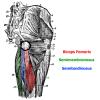Folders |
Running Economy: Barefoot vs. Shod Running
Published by
n yesterday’s post we discussed briefly the three general foot strike patterns. If you recall, the habitually barefoot athlete most frequently strikes the ground with a FFS or MFS, whereas the shod runner most often makes contact ahead of his center of mass with a RFS. This differentiation is critical for a number of reasons, and particularly energy return and increased economy. It seems that prior to foot strike, the barefoot athlete “pre-activates” the triceps surae to increase the stiffness of the ankle, which is the primary means of developing lower extremity stiffness and ultimately contributes to greater running economy (Nigg, 2001; Hobara, 2007; Albracht, 2006). This pre-activation leads to a greater return of elastic energy via stretch-shortening cycle, and with other things, ultimately leads to a more powerful and efficient stride. The lower leg is rife with muscles that are reasonably short, with relatively long tendons, and it is believed that these muscles are better suited for efficient energy return than any other set of muscles in the lower extremity (Bosch, 2005; Sawicki, 2009). The Achilles tendon is capable of returning upwards of 35% of the stored elastic energy, making it the most efficient of all. Shoe designers over the years have added an elevated heel to “protect” the Achilles from excessive strain, but maybe at the cost of effective use of the spring mechanism. Additionally, the medial longitudinal arch has the capacity to return upwards 17% stored elastic energy, but a MFS or a FFS are far better at translating this energy into motion than a rearfoot strike. To gain a full appreciation of the differences, we must first understand that the subtalar joint is capable of translating rotational forces that contribute to economical locomotion. Pronation leads to a relative internal rotation at the tibia, which places a torsion on the elastic structures within the IT band, helping to load the hip during stance (Oatis, 2004). In RFS patterns, athletes strike directly below the ankle and with uncertain levels of plantar flexion (with the collision taking up a great deal of translational energy), thus limiting the ability to convert translational energy into rotational energy. In FFS and MFS patterned athletes, strike the ground forward of the ankle and often with the lateral aspect of the forefoot, and though stance progressive, controlled dorsiflexion and pronation results in greater torques converted into rotational energy (Lieberman, 2010). Additionally, with pronation, the medial longitudinal arch “flattens” and stores elastic energy. Rearfoot strikers are at a disadvantage in using this mechanism because the medial longitudinal arch is unable to “pre-load” until both rearfoot and forefoot are on the ground. Barefoot athletes who are midfoot or forefoot strikers have the luxury of MLA loading during the entire first half of stance as well as in the latter half when the Windlass Mechanism reaches full levels of function. Given that 70-80% of today’s distance runners heel strike as a potential result of shoes (Hasegawa, 2007), this may limit efficiency. Additionally, today’s shod runners often run with orthoses and “arch supporting” shoes that limit the downward deflection of the MLA and ultimately lead to a less efficient mass-spring component of gait further (Robbins, 1987). Of course, one must also consider the foot intrinsic musculature’s response to footwear. Many suggest that, like during immobilization, atrophy of the small plantar muscles occur as a result of wearing “supportive” shoes, which in turn reduces efficiency further. When these muscles do not function strongly or exhibit appropriate motor control, excessive pronation is often a result. Interestingly, these muscles fight harder during pronation to protect the plantar fascia from excess strain, but it is a losing battle., which may lead to bigger problems down the line. Of course, when the intrinsics are unable to convert the foot from a force absorber to a force transducer through stance, efficiency and power is lost so the body must look for other ways to gain speed. The result is often “muscling” it from the anterior musculature of the hip, that is often overactive as is. From an efficiency standpoint, barefoot running is probably superior to shod. That said, before you go and start running entirely barefoot, however, I’d suggest you pay close attention to the posts to follow that involve the Boddicker Performance assessment, warning signs, and progression advice to determine if you are prepared to run unshod. Best regards, Carson Boddicker
|




